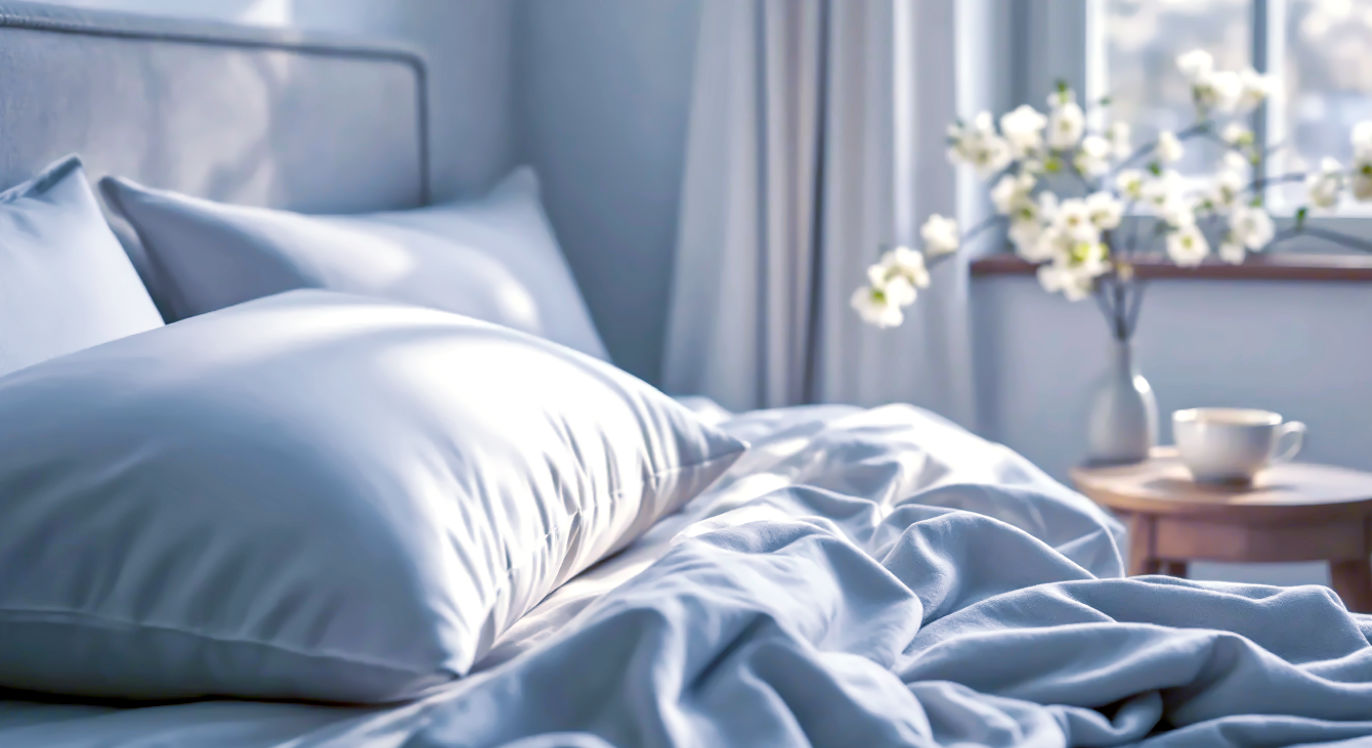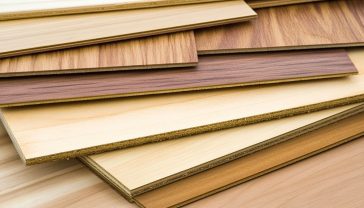The Perfect Pillowcase: A Brit’s Guide to Winning at Sleep
Discover how the right pillowcase can transform your sleep, skin, and hair. Our ultimate guide compares silk, cotton, linen, and more for UK sleepers.

This post may contain affiliate links. If you make a purchase through these links, we may earn a commission at no additional cost to you.
Let’s be honest, when was the last time you gave your pillowcase a second thought? For most of us, it’s just that bit of fabric that stops you from dribbling directly onto your pillow. It probably came in a set with your duvet cover, got chucked in the wash with everything else, and that was that.
But what if I told you that humble rectangle of cloth is one of the most important things in your bedroom? What if it holds the secret to better skin, healthier hair, and a truly restorative night’s sleep? It sounds a bit dramatic, I know. But stick with me. Choosing the right pillowcase isn’t just about matching your colour scheme; it’s a simple, game-changing upgrade for your well-being.
Think about it. Your face and hair are in direct contact with this surface for roughly eight hours every single night. That’s a third of your life. Over a year, it adds up to over 3,000 hours. Suddenly, the material you’re pressing your face against seems a lot more important, doesn’t it?
In this guide, we’re going to pull back the covers on the world of pillowcases. We’ll explore everything from luxurious silk that feels like a dream on your skin to crisp, cool cotton that reminds you of a boutique hotel. We’ll get into the nitty-gritty of thread counts, weaves, and why some materials are brilliant for your hair while others can leave you with a frizzy bird’s nest in the morning.
This isn’t just about fancy fabrics. It’s about turning your bed into a sanctuary. It’s about understanding how a small change can lead to a big difference in how you look and feel when you wake up. So, let’s get comfortable and find the perfect pillowcase to help you win at sleep.
Why Your Pillowcase Is More Than Just a Pillow Cover
At its most basic, a pillowcase protects your pillow. It acts as a barrier against the sweat, oils, dead skin cells, and hair products that you transfer from your body every night. Without it, your pillow would become a stained, unhygienic breeding ground for dust mites and bacteria pretty quickly. Lovely.
But its job goes far beyond simple protection. The right pillowcase is a key player in what sleep experts call ‘sleep hygiene’. This isn’t just about cleanliness; it’s about creating the perfect environment for deep, uninterrupted rest. This includes everything from the temperature of your room to the comfort of your bedding.
Here’s how your pillowcase fits in:
- Temperature Regulation: Do you ever find yourself flipping your pillow over to get to the ‘cool side’? Some fabrics are naturally breathable and wick moisture away, helping to keep you cool and comfortable all night long. Others trap heat, which can lead to a sweaty, restless night.
- Skin Health: The texture of your pillowcase matters. Rough, abrasive materials can irritate your skin, contributing to redness and inflammation. Worse, some fabrics absorb all the moisture from your skin and any expensive face creams you’ve applied, leaving your face dry and your pillowcase greasy.
- Hair Care: Ever woken up with tangled, frizzy hair? Your pillowcase could be the culprit. Coarse fabrics, like some types of cotton, can create friction, roughing up the hair cuticle and leading to breakage and frizz. This is especially true if you have curly, fine, or delicate hair.
- Allergy Management: Pillowcases can trap allergens like dust mites, pollen, and pet dander. Hypoallergenic materials can provide a protective barrier, helping you to breathe easier and wake up without feeling stuffy.
For something so simple, it has a surprisingly big job. It’s the unsung hero of your bedding, working quietly through the night to support your health and comfort. Now, let’s look at the materials that do it best.
The Great Fabric Debate: Silk vs. Cotton vs. The Rest
Choosing a pillowcase material can feel a bit overwhelming. There are so many options, each claiming to be the best. Let’s break down the main contenders you’ll find in British shops and online, so you can figure out what’s right for you.
Silk: The Height of Luxury and Care
For decades, silk has been the top choice for those in the know about beauty. It’s not just hype; the benefits are real. Silk is a natural protein fibre produced by silkworms. It’s famous for being incredibly smooth, strong, and shimmery.
But not all silk is created equal. You’ll often see a measurement called ‘momme’ (pronounced ‘mom-mee’). This is a Japanese unit of weight that measures silk density and quality. Think of it like thread count for cotton.
- 17-19 momme: Good quality, but on the thinner side.
- 22 momme: This is the sweet spot. It offers a perfect balance of durability, softness, and value. It’s what most high-quality silk pillowcases are made from.
- 25-30 momme: Extremely luxurious, heavy, and durable, but it comes with a much higher price tag.
What kind of silk should you look for?
The absolute best is 100% Mulberry silk. This is the highest quality silk available. It comes from silkworms that are fed an exclusive diet of Mulberry leaves, resulting in long, uniform fibres that are incredibly smooth and strong.
Pros of Silk:
- Kind to Hair: The super-smooth surface means less friction. Your hair glides over the pillowcase, which means fewer tangles, less breakage, and reduced frizz. It’s a lifesaver for people with curly, coily, or damage-prone hair.
- Great for Skin: Silk is less absorbent than cotton. This means it doesn’t soak up your skin’s natural moisture or your expensive night creams. It also helps reduce sleep creases – those temporary wrinkles you get from your face being squashed against the pillow.
- Naturally Hypoallergenic: Silk is resistant to dust mites, mould, and fungus, making it a brilliant choice for allergy sufferers.
- Temperature Regulating: It’s a bit of a marvel. Silk can feel cool in the summer and warm in the winter, helping to maintain a comfortable sleeping temperature.
Cons of Silk:
- The Price: Let’s not beat around the bush. A genuine, high-quality Mulberry silk pillowcase is an investment. A single one can cost anywhere from £40 to over £90.
- The Upkeep: It’s delicate. Most silk pillowcases need to be hand-washed or put on a very gentle machine cycle with a special silk detergent. You can’t just bung it in a hot wash with your towels.
- Slippery! Some people find silk a bit too slippery, and their pillow can feel like it’s trying to escape from under their head all night.
Who is it for? Anyone serious about their skincare or haircare routine, allergy sufferers, or those who just want to add a touch of five-star luxury to their bedtime.
Cotton: The Trusty, Versatile Classic
Cotton is the most popular bedding material in the world, and for good reason. It’s breathable, durable, and generally affordable. But when you start shopping, you’ll see a whole world of different cottons, weaves, and thread counts.
Understanding Thread Count
Thread count is the number of threads woven into one square inch of fabric. For years, marketing departments have screamed that “higher is better!” But that’s not always true. A super-high thread count (800+) can sometimes mean that thinner, weaker threads have been used, or that manufacturers have twisted multiple threads together. This can result in a fabric that isn’t very breathable and doesn’t last long.
A good rule of thumb for cotton pillowcases is to look for a thread count between 300 and 500. This generally offers a great balance of softness, durability, and breathability.
Types of Cotton:
- Egyptian Cotton: Widely considered the king of cottons. It’s grown in the Nile River Valley and has extra-long fibres (or staples). These long fibres can be spun into very fine, strong yarns, creating fabric that is incredibly soft, durable, and resistant to pilling (those annoying little bobbles).
- Pima Cotton: Another high-quality, long-staple cotton, mainly grown in the USA. It’s very similar to Egyptian cotton in terms of softness and durability. Supima® is a trademarked brand of American Pima cotton.
- Standard Cotton: Often just labelled “100% cotton,” this is usually made from shorter-staple cotton. It’s more affordable but won’t feel as soft or last as long as its premium cousins.
Types of Weave:
The way the cotton threads are woven together dramatically affects how the fabric feels.
- Percale: This is a simple, plain weave. It feels light, crisp, and cool to the touch – like the sheets in a fancy hotel. It’s very breathable, making it perfect for people who tend to get hot at night.
- Sateen: This weave has more threads on the surface, which gives it a silky-smooth feel and a subtle sheen. It feels slightly heavier and warmer than percale, so it’s a good choice for those who prefer a cosier feel.
Pros of Cotton:
- Breathable and Absorbent: Cotton is great at letting air circulate, which helps to keep you cool.
- Durable and Easy to Care For: Most cotton pillowcases can be machine-washed and tumble-dried, making them very low-maintenance.
- Variety: There’s a huge range of colours, patterns, qualities, and price points to suit every taste and budget.
Cons of Cotton:
- Can be Harsh on Hair and Skin: The absorbent nature of cotton means it can draw moisture away from your skin and hair. Its texture, even at high thread counts, creates more friction than silk, which can contribute to hair frizz and sleep creases.
- Wrinkles Easily: Especially percale weave cotton, which can look quite creased straight out of the wash.
Who is it for? People who love a crisp, cool feel, those who get hot at night, or anyone looking for a durable, easy-care option that won’t break the bank.
Linen: The Effortlessly Chic, Sustainable Choice
Linen is made from the fibres of the flax plant. It’s one of the oldest textiles in the world and is loved for its relaxed, slightly crumpled look and incredible durability. In recent years, it’s become hugely popular in the UK for its eco-credentials and laid-back Scandi-chic vibe.
Pros of Linen:
- Extremely Breathable: Linen is a fantastic temperature regulator. It has natural hollow fibres that allow air to circulate freely, making it feel cool in the heat and warm in the cold.
- Gets Softer with Age: Unlike other fabrics that wear out, linen actually gets softer and more comfortable with every wash. A good linen pillowcase is an investment that will last for years.
- Highly Absorbent and Quick-Drying: It can absorb a lot of moisture without feeling damp, which is great for hot sleepers.
- Sustainable: The flax plant is very resilient. It can grow in poor soil and requires very little water or pesticides compared to cotton.
Cons of Linen:
- The Wrinkles: Linen is famous for its creases. If you want a perfectly smooth, pristine bed, linen is not for you. You have to embrace its naturally relaxed look.
- The Texture: When new, linen can feel a bit crisp or even rough to some people. It takes a few washes to achieve that signature softness.
- The Price: Good quality linen is more expensive than cotton due to the more labour-intensive production process.
Who is it for? Hot sleepers, eco-conscious shoppers, and anyone who loves a relaxed, natural aesthetic in their bedroom.
Other Materials to Consider
- Satin: Don’t confuse this with silk! Satin is a weave, not a fibre. Most affordable “satin” pillowcases are made from polyester. They offer a similar smooth, slippery feel to silk at a fraction of the price and are a good vegan alternative. However, polyester is a synthetic material made from petroleum. It’s not very breathable and can make you feel sweaty.
- Bamboo: Bamboo fabric (usually bamboo viscose or rayon) is known for being incredibly soft, smooth, and moisture-wicking. It’s often touted as a sustainable option, but the process of turning tough bamboo pulp into soft fabric can involve harsh chemicals. Look for certifications like OEKO-TEX® to ensure it’s free from harmful substances.
- Flannel: This is a cotton fabric that has been brushed to raise the fibres, creating a soft, fuzzy surface. It’s perfect for cold winter nights, giving you an instant feeling of warmth and cosiness, but it’s far too hot for the rest of the year.
Material Comparison at a Glance
| Feature | Silk (Mulberry) | Cotton (Percale) | Linen | Satin (Polyester) |
|---|---|---|---|---|
| Feel | Ultra-smooth, luxurious | Crisp, cool, light | Soft (gets softer), textured | Slippery, smooth |
| Best For Hair | ★★★★★ | ★★☆☆☆ | ★★★☆☆ | ★★★★☆ |
| Best For Skin | ★★★★★ | ★★★☆☆ | ★★★★☆ | ★★★☆☆ |
| Breathability | ★★★★☆ | ★★★★★ | ★★★★★ | ★☆☆☆☆ |
| Durability | ★★★☆☆ | ★★★★☆ | ★★★★★ | ★★★☆☆ |
| Care | Delicate, hand-wash | Easy, machine-wash | Easy, gets softer | Easy, machine-wash |
| Price | ££££ | ££ | £££ | £ |
How to Choose Your Perfect Pillowcase: A Practical Checklist
Now you know the main players, how do you decide? Here’s a step-by-step guide to finding the one for you.
1. Identify Your Primary Goal
What is the main problem you’re trying to solve? Be honest with yourself.
- “I want to wake up with smoother hair and skin.” -> Your top choice is Mulberry silk. If that’s out of your budget, a good quality sateen cotton or a bamboo pillowcase is a decent alternative.
- “I’m always too hot at night.” -> You need something breathable. Linen is the champion here, closely followed by cotton percale.
- “I have sensitive skin or allergies.” -> Look for naturally hypoallergenic materials like silk or bamboo. Also, check for the OEKO-TEX® Standard 100 certification. This means the fabric has been tested and certified to be free from harmful levels of over 100 substances known to be harmful to human health.
- “I just want something durable and easy to wash.” -> Cotton is your best bet. A good quality Pima or Egyptian cotton pillowcase will last for years and can handle regular machine washing.
- “I’m trying to be more environmentally friendly.” -> Linen is a strong contender. You could also look for organic cotton, which is grown without synthetic pesticides and fertilisers.
2. Consider Your Budget
A pillowcase is something you use every single night, so it’s worth investing in the best quality you can afford.
- Budget-Friendly (£10-£25 per pair): You’ll find good quality standard cotton, polyester satin, and some cotton-poly blends in this range.
- Mid-Range (£25-£60 per pair): This is where you’ll find high-quality cottons like Egyptian and Pima, as well as good linen and bamboo options. You might also find a single silk pillowcase at the top end of this range.
- Luxury (£60+): This is the realm of premium 22-momme Mulberry silk pillowcases and high-end linen.
Remember, a single high-quality silk or linen pillowcase that you use every night can be a better investment than a cheap multi-pack that you have to replace every year.
3. Check the Details
Once you’ve chosen your material, look at the construction.
- Closures: How does the pillowcase close? An envelope closure has a flap of fabric at the end to tuck the pillow in, which looks neat and stops the pillow from peeking out. A zip closure is even more secure. A standard ‘housewife’ pillowcase has a simple sewn edge, while an ‘Oxford’ pillowcase has a decorative fabric border around the edges.
- Sizing: The standard UK pillow size is 50cm x 75cm. Most pillowcases are sold in this size. If you have a square or king-size pillow, make sure you buy the corresponding pillowcase. There’s nothing more annoying than a pillowcase that’s too baggy or too tight.
Caring For Your Pillowcase to Make It Last
You’ve invested in the perfect pillowcase. Now you need to look after it properly to get the most out of it.
How often should you wash your pillowcase?
The expert consensus is once or twice a week. This might sound like a lot, but think about it: all that sweat, oil, and product builds up fast. Washing your pillowcase regularly is one of the simplest things you can do for your skin health.
Washing Instructions by Fabric:
- Silk: This is the high-maintenance one. Always check the label. The best method is to hand wash in cool water with a special pH-neutral liquid detergent designed for silk or delicates. Don’t wring it out. Gently squeeze out the excess water and roll it in a towel. Air dry it away from direct sunlight, which can damage the fibres and cause colours to fade. If the label says you can machine wash, use a delicates cycle (no higher than 30°C), turn the pillowcase inside out, and place it in a mesh laundry bag to protect it.
- Cotton: Easy peasy. Most cotton can be washed at 40°C, which is effective for cleaning. For a deeper clean, you can occasionally wash white cotton at 60°C, but check the care label first as high temperatures can cause some shrinkage or fading over time.
- Linen: Linen is robust. You can machine wash it at 40°C. It will get softer with every wash. Avoid using fabric softener, as it can coat the fibres and reduce their natural absorbency and breathability. Linen can be tumble-dried on a low heat, but it’s best to air dry it if you can.
- Bamboo & Synthetics: These can generally be washed at 30°C or 40°C on a gentle cycle. Avoid high heat in the tumble dryer, as it can damage the fibres.
A final top tip: Avoid using harsh detergents or fabric softeners on any of your bedding. They can leave a residue that irritates the skin and can break down the natural fibres of the fabric over time. A simple, non-bio detergent is often the best choice.
The Final Verdict: Is There One ‘Perfect’ Pillowcase?
So, after all that, what’s the answer? The truth is, the ‘perfect’ pillowcase is different for everyone. It depends entirely on your personal priorities, your budget, and what you find comfortable.
If your main goal is to invest in the health of your hair and skin, and you don’t mind the price tag or the delicate washing instructions, then a 22-momme Mulberry silk pillowcase is, without a doubt, the winner. The difference it can make is remarkable.
If you’re a hot sleeper who craves a breathable, natural fabric and you love a relaxed, lived-in look, then 100% linen will be your perfect match. It’s an investment that truly gets better with age.
And if you want a no-fuss, classic option that feels crisp and cool and will stand up to years of washing, you simply can’t go wrong with a high-quality Egyptian or Pima cotton percale.
Don’t underestimate the power of this simple piece of fabric. Your pillowcase is with you through thick and thin, for roughly 26 years of your life. Choosing the right one is a small act of self-care, a simple upgrade that can transform your nights and, in turn, your days. It’s not just about sleeping; it’s about sleeping well. And you certainly deserve that.
Further Reading
For those who wish to delve deeper into the science of sleep and textiles, these resources are highly recommended:
- The Sleep Charity: A leading UK charity providing advice and support on achieving a better night’s sleep. https://thesleepcharity.org.uk/
- Which? Bedding Guides: The trusted UK consumer champion offers impartial reviews and buying guides for all types of bedding. https://www.which.co.uk/
- OEKO-TEX® Label Check: Verify the validity of the OEKO-TEX® certification on any textile product. https://www.oeko-tex.com/en/label-check






